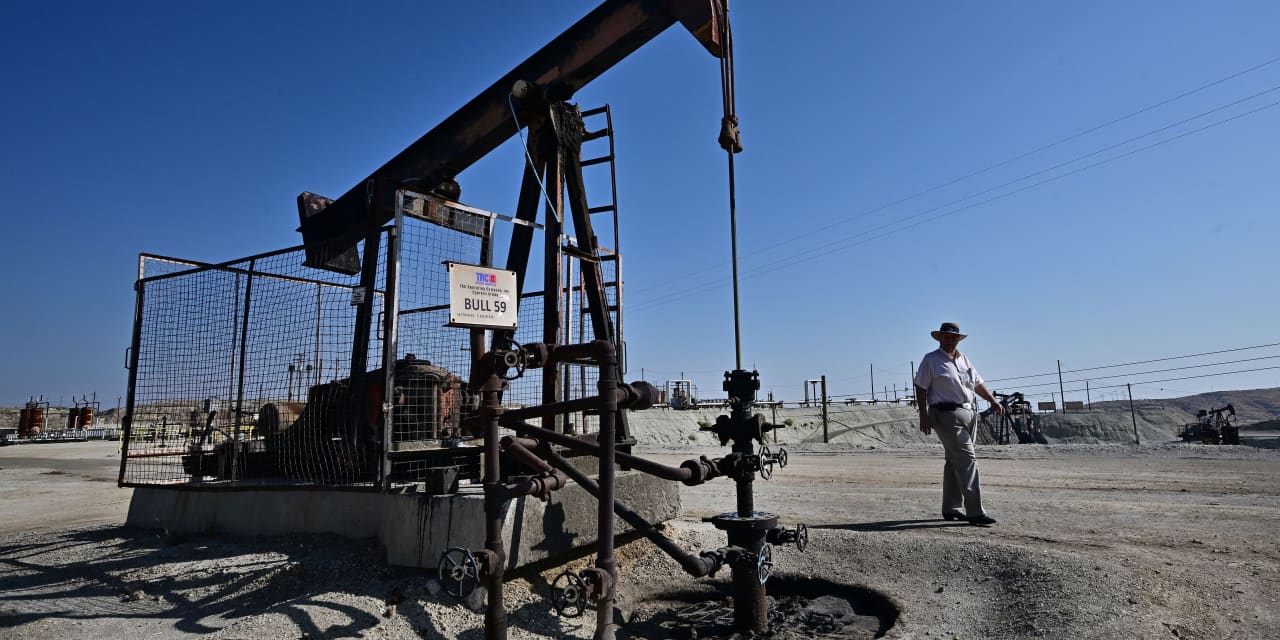Oil-and-gas companies will start reporting their third-quarter earnings this week, and the outlook isn’t very rosy.
Earnings are expected to decline by 38% year over year, more than any other sector of the
S&P 500
by far. The biggest reason is oil and natural-gas prices declined by double digits, in percentage terms, from the same quarter a year ago. And yet, energy stocks are in relatively good shape, gaining 11% in the third quarter even as the broader market slumped. These stocks have more Buy ratings than any other sector, according to FactSet.
That split between earnings expectations and stock sentiment shows just how much energy companies have changed from a decade ago, when oil prices were pretty much the only thing that mattered. Now, the companies are increasingly valued for steady cash flow, strong dividends, and as a hedge against inflation. Oil-and-gas companies will start reporting third-quarter earnings this week from a position of strength: Independent American oil producers are producing more oil as major state-owned operators elsewhere have cut production. U.S. output hit all-time highs of 13.2 million barrels a day last week.
All that said, energy companies could have trouble convincing investors that they’ll remain attractive investments after their stocks’ recent strong performance and uncertainty about oil prices.
Oil is trading in a range between $80 and $90 a barrel—staying under $100 despite the Israel-Hamas war, OPEC’s production cuts, and Russia’s continuing invasion in Ukraine. Concerns about demand are currently outweighing those supply shocks. Natural-gas prices had risen above $3.30 earlier this month, but have since declined below $3.10. For energy stocks to rise further, commodity prices might have to break above their current ranges.
Geopolitical uncertainty could outweigh most company-specific news as companies start reporting earnings, according to Mizuho analyst Nitin Kumar.
“We believe investors will be more focused on macro trends (e.g., Israel-Gaza conflict, oil demand outlook, U.S. natural gas supply and pricing, shale M&A etc.) and the messaging from companies on how they fit into those trends during this upcoming earnings season,” Kumar wrote.
Investors might get an answer to one big question hanging over the sector—whether U.S. oil companies will spend less on drilling—when oil services company
SLB
(ticker: SLB) reports earnings Friday morning. In the U.S., oil companies have been cutting the number of rigs they use as they stick to modest capital expenditure budgets and only drill their best wells. The U.S. rig count fell by 10% in the third quarter. That has hurt profits of oil services firms like
Halliburton
(HAL), which is dominant in the U.S.
SLB, however, is more focused on the international market, including working on large offshore drilling projects. The company could provide insight on whether U.S. drilling has hit a bottom and whether international activity will keep rising. Raymond James analyst James Rollyson says international oil services should stay strong and that the U.S. market is “likely nearing a bottom,” making several of the oil services names attractive. He has Strong Buy ratings on Halliburton,
Atlas Energy Solutions
(AESI),
Patterson-UTI Energy
(PTEN), Select Water Solutions (WTTR),
Tidewater
(TDW), and
Weatherford International
(WFRD).
Another trend investors will likely watch for this earnings season is M&A, to see if other oil companies will follow
Exxon Mobil
‘s (XOM) lead and consolidate. Exxon announced last week that it will buy
Pioneer Natural Resources
(PXD) for about $65 billion, a deal that will make it the dominant shale-oil producer in the country by far. Analysts have speculated that more deals could be coming, as larger oil companies have technological and financial advantages over their smaller peers.
Among the companies to monitor for M&A signals is oil major
Chevron
(CVX), which could be a buyer. The company reports third-quarter results on Oct. 27.
Diamondback Energy
(FANG),
Devon Energy
(DVN) and
Coterra
(CTRA) have been mentioned by analysts as companies that could eventually be acquired because they are large enough to move the needle for a big oil company. They will report quarterly results in November.
Still, some are skeptical that those companies have the right attributes to be targets right now. Kumar wrote that no other major shale company has inventory that can compare with that of Pioneer: “For investors looking for the ‘next Pioneer’ the drop off in both market cap and reserves to the next independent large-cap E&P [exploration and production company] is relatively sharp.”
Another big question for energy companies is the direction of gasoline prices. Refiners such as
Valero
Energy (VLO) and
Phillips 66
(PSX) have made wide margins selling expensive diesel fuel as Russia and other players export less of it to Europe. Refiner stocks rose 27% in the third quarter, according to Tudor, Pickering, Holt. But they’re making much less money on gasoline now, as Americans are driving less and gas prices have been falling. Investors will want to know if refiners expect gasoline margins to pick back up and whether gas prices are likely to stay low for months, possibly hurting fourth-quarter earnings.
Valero and Phillips will post quarterly results in late October.
Write to Avi Salzman at [email protected]
Read the full article here



